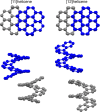Effect of [ n]-Helicene Length on Crystal Packing
- PMID: 38076527
- PMCID: PMC10704484
- DOI: 10.1021/acs.cgd.3c00964
Effect of [ n]-Helicene Length on Crystal Packing
Abstract
Chiral π-conjugated organic molecules hold potential for emerging technologies as they are capable of introducing novel functionalities into electronic devices owing to their strong chiroptical properties. However, capitalizing on chiral molecules for electronic devices is reliant on their molecular packing-a factor that impacts their charge-transport properties. The solid-state behavior of molecules is sensitive to subtle differences in molecular interactions, chirality, and shape, but these relationships are not fully understood. Here, we employ crystal structure prediction (CSP) as a tool to probe the lattice-energy landscape for a family of chiral organic molecules: [n]helicenes, where n ranges from 3 to 12. Our results show excellent agreement between the CSP landscapes and experimentally reported structures. By analyzing the packing motifs within the polymorph landscapes, we begin to develop an understanding of how helicene length affects the shape and π-π stacking interactions seen in the polymorphs. Furthermore, we propose how helicene length can be used as a tool to design new functional organic electronics.
© 2023 The Authors. Published by American Chemical Society.
Conflict of interest statement
The authors declare no competing financial interest.
Figures






References
-
- Bässler H.; Köhler A.. Unimolecular and Supramolecular Electronics I: Chemistry and Physics Meet at Metal-Molecule Interfaces. Topics in Current Chemistry; Metzger R. M., Ed.; Springer: Berlin, Heidelberg, 2012; pp 1–65.
LinkOut - more resources
Full Text Sources
Research Materials
Miscellaneous
